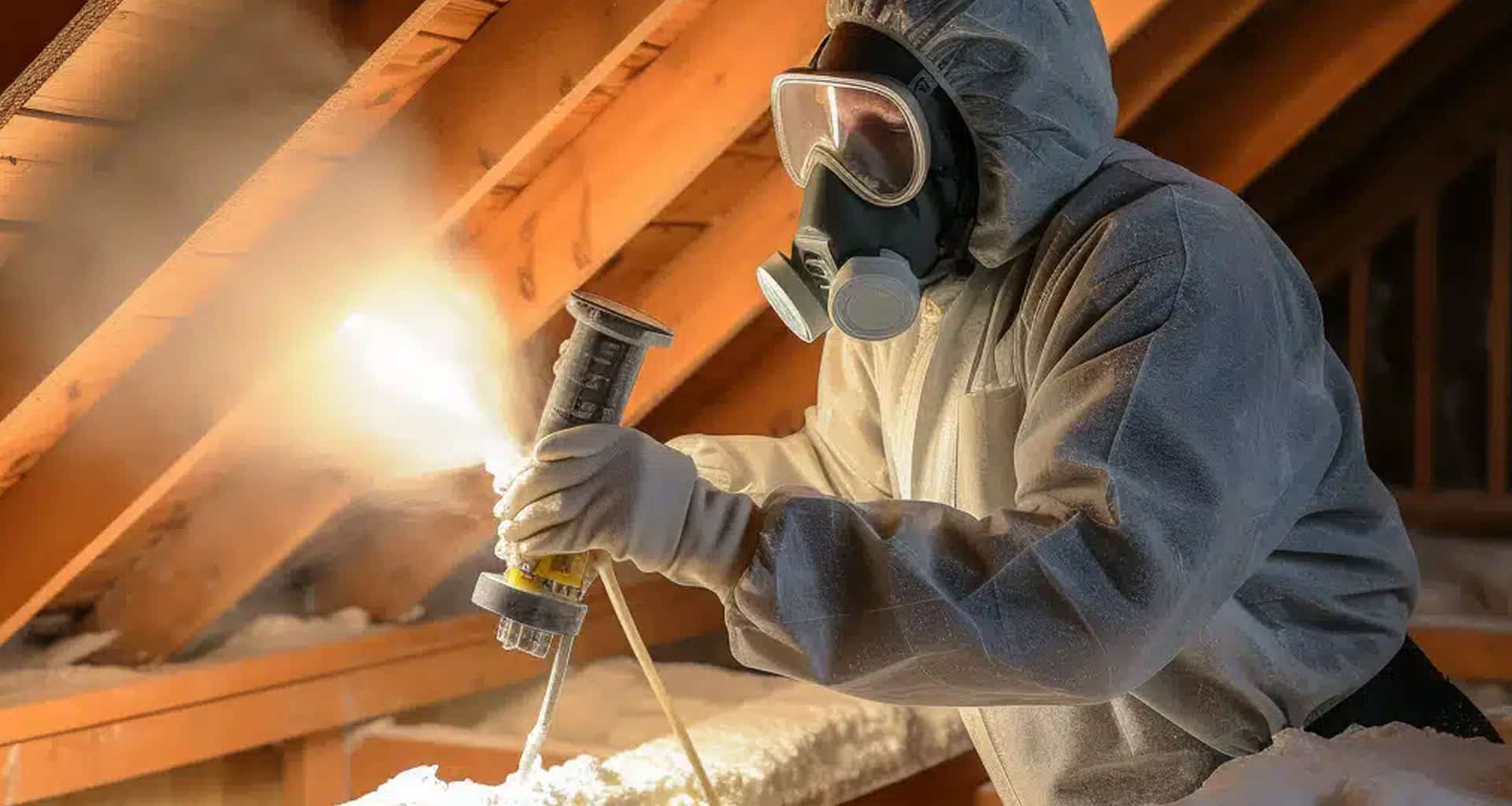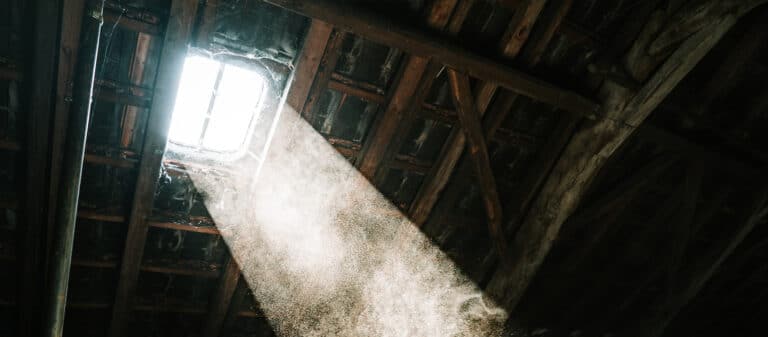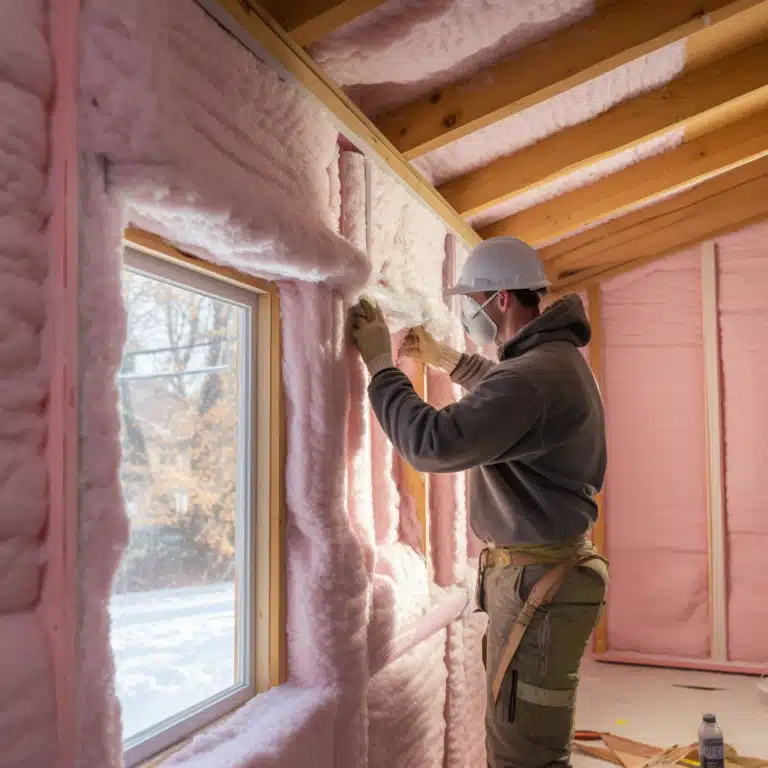One way to fight back against inflation is with insulation.
As gas and electric prices in Pennsylvania ebb and flow, you can reduce how much energy you expend in a given month heating your home with the right insulation materials.
In this guide, we’ll explain everything you need to know to prepare your home for next winter, including the best insulation for cold weather in NEPA and tips to maximize your insulation’s value.
Understanding R-Value
When shopping for new insulation, you will see many different types of materials labeled and advertised by their R-value.
Insulation R-value is simply a measure of an insulation material’s effectiveness at blocking out or preserving heat in a given space. The higher the R-value, the better the insulation.
Insulation R-values typically go as low as R-13 and as high as R-60.
The R-value of any insulation is based on a few given factors:
- Material
- Material Thickness
- Material Density
For example, applying 6 inches of closed-cell spray foam with an R-value of R-7 per inch will produce an R-value roughly equivalent to R-42.
Ideally, choosing a higher R-value will yield the most bang for your buck. But, as a matter of budget, certain areas of your home will demand greater insulation than others.
Proper R-Value for Homes in Scranton
Based on IECC climate zones, EnergyStar recommends the following R-values of insulation for homes in Scranton.
| Part of Home | R-Value (Non-Insulated) | R-Value (Previously Insulated) |
| Attic | R-60 | R-49 |
| Walls | R-5 to R-10 (Sheathing) | R-10 (Sheathing |
| Floors | R-30 | R-30 |
| Basement/Crawl Space | R-15 (Sheathing) to R-19 (Batts) | R-15 (Sheathing) to R-19 (Batts) |
Knowing these values, you can purchase the right insulation materials for each area of your house to maximize your return on investment.
Best Areas to Insulate for Cold Weather
When it comes to getting the best bang for your buck, remember that location, location, location matters a lot.
Many of our customers think that walls are the best place to start insulating, but you can significantly cut back heat loss by targeting a few overlooked areas.
Attics
Thermodynamics tells us a very simple fact: heat rises.
According to HSA Home Warranty, nearly 25% of all heat loss is lost through your attic. While walls and windows may account for just as much, the attic is often the easiest and most cost-efficient area of the home to insulate.
There are a variety of insulation materials you can install in your attic, including:
- Closed cell foam
- Blown-in cellulose or fiberglass
- Fiberglass batts and rolls
Just be sure to choose a material that will offer the necessary R-value to minimize heat loss as much as possible.
Air Sealing
To maximize the value of any insulation project, you should strongly consider air sealing your attic. Most traditional insulating materials cannot account for drafts that result from:
- Kneewalls
- Furnace flues
- Recessed can lighting
An air seal using traditional caulk and spray foam will help eliminate backdrafts that cause warm air to escape and cool air to penetrate your attic.
Crawl Spaces
The next biggest culprit of unintentional heat loss could be your basement. Again, many people tend to ignore crawl spaces because heat rises, but it could also be a huge purveyor of cold air that sweeps through your basement and causes drafts your heating system has to contend with.
Spray foam or rigid foam boards offer the best protection for crawl spaces and the greatest resistance to moisture–something else you need to think about when you purchase insulation.
Rim Joists
Rim joists are a small section of open wall cavities between your basement and first-floor subfloor. In older homes, this area is often left uninsulated and can be a massive source of heat loss if your primary heating source comes from the basement.
Walls
Walls account for massive heat loss, though installing new insulation for walls is often more expensive and intrusive than in other areas of your home. Foam injection and blown-in insulation are available through most insulation contractors and only involve drilling a small hole in your siding to access a closed-off wall cavity.
For newer homes, spray foam insulation remains the gold standard when insulating walls or any area of your home.
Best Types of Insulation for Cold Weather
Below, we’ve listed three insulating materials for cold weather that will offer the best value for your home.
Spray Foam
While R-values for spray foam vary, open-cell foam has an average R-value of R-3.6 to R-3.9 per inch, and closed-cell foam at R-6 to R-7 per inch. Applying closed-cell foam will require less foam to achieve a satisfactory R-value.
While spray foam insulation tends to offer the highest R-value, there are many benefits to spray foam insulation that go beyond these measures.
- Complete Air Seal: Unlike other insulation materials, spray foam seals all gaps and cracks entirely. This eliminates the need for caulking or patching any holes in your attic, rim joist, or walls.
- Moisture Resistance: Spray foam is entirely moisture resistant, preventing any risk of mold or mildew that can develop over time on other insulating materials.
- Long-Lasting: Spray foam lasts up to 100 years, whereas traditional fiberglass batts may only last 15-20 years.
- Eco-Friendly: Spray foam insulation is made with eco-friendly materials.
Fiberglass
Fiberglass is considered the next best insulating material in terms of R-value and durability. The average value of loose fiberglass is around R-3.1 to R-3.4 per inch, whereas batts and rolls can go up to 3.9 per inch.
Most stores offer packages where you can purchase thick rolls or batts of insulation with a total R-value of R-19- to R-60.
Blown-in fiberglass is an excellent option for homes without existing insulation that needs to fill hard-to-reach wall cavities, gabled walls, and ceilings. Likewise, batts and rolls are very effective at insulating behind open wall cavities and attic floors, though more labor is required.
Blow-In Cellulose
Finally, blown-in cellulose insulation offers a sturdy R-value of R-3.5 per inch and is effective for insulating existing wall cavities, attic ceilings, and above garages. Best of all, cellulose is made of recycled materials treated with flame-retardant chemicals that prevent mold and moisture and resist fire.
Should I Keep My Old Insulation?
Depending on the quality of your existing insulation, it is possible to install new insulation on top of old blown-in insulation. For example, adding new fiberglass rolls (unfaced) over existing blow-in fiberglass insulation can compound the R-value of your existing insulation to create a better heat barrier.
Likewise, two rolls can be installed on top of one another, or a spray foam can be applied behind existing batts for more protection.
Insulation removal in Pennsylvania is recommended if the existing insulation has become black or is subject to mold/mildew.
| Warning: Be weary of any moisture issues that can arise from doubling up insulation. For example, stacking fiberglass batts that restrict airflow can lead to moisture buildup. Likewise, be sure that any new insulation you or a contractor installs does not impede ventilation in your attic space. |
Making the Most of Your Insulation
Regardless of what insulation materials you use, what matters most is where and how they are installed. That’s why hiring an experienced insulation contractor is so important.
While some areas of your home can be insulated DIY, you won’t get the full benefit you would by hiring a professional who can insulate and air seal the envelope of your home.
Be sure to choose the best insulation materials for your home and to work with a professional who can maximize their value.
FAQs: Best Insulation for Cold Weather
Can I mix different types of insulation in my home?
Yes, it is possible to mix different types of insulation material, such as fiberglass rolls, with a top layer of cellulose or vice versa, as long as the materials are in good condition and won’t lead to any moisture issues.
Are there government incentives for upgrading insulation?
The federal government offers several insulation tax credits, including the 25C credit, available for up to 30% of all insulation materials you purchase in a year (capped at $1,200 or $4,000 in new materials). This credit only includes material costs, not labor, and requires a receipt for all materials purchased.
How often should insulation be inspected and replaced?
Insulation can last for up to 20-100 years, depending on the quality of the product. Therefore, it’s up to the homeowner how often they want to inspect insulation materials. As a rule of thumb, you should inspect your insulation annually to look for any signs of mold, mildew, or extreme moisture buildup.










